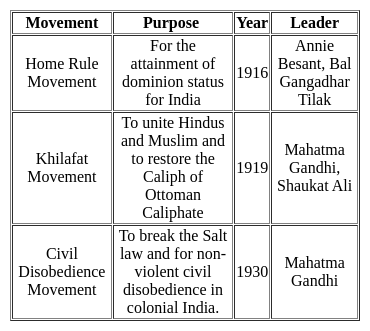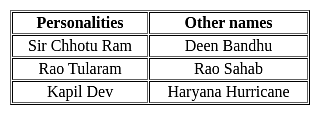Software Development Exam > Software Development Tests > Test: Modern History of Haryana - Software Development MCQ
Test: Modern History of Haryana - Software Development MCQ
Test Description
20 Questions MCQ Test - Test: Modern History of Haryana
Test: Modern History of Haryana for Software Development 2025 is part of Software Development preparation. The Test: Modern History of Haryana questions and answers have been prepared
according to the Software Development exam syllabus.The Test: Modern History of Haryana MCQs are made for Software Development 2025 Exam.
Find important definitions, questions, notes, meanings, examples, exercises, MCQs and online tests for Test: Modern History of Haryana below.
Solutions of Test: Modern History of Haryana questions in English are available as part of our course for Software Development & Test: Modern History of Haryana solutions in
Hindi for Software Development course.
Download more important topics, notes, lectures and mock test series for Software Development Exam by signing up for free. Attempt Test: Modern History of Haryana | 20 questions in 20 minutes | Mock test for Software Development preparation | Free important questions MCQ to study for Software Development Exam | Download free PDF with solutions
Test: Modern History of Haryana - Question 1
At which place of Haryana, women participated in a movement which was started by daughters of Lala Duli Chand, namely, Vidhyawati, Yashoda and Jamuna?
Detailed Solution for Test: Modern History of Haryana - Question 1
Test: Modern History of Haryana - Question 2
In 1919, the first protest against the Rowlatt Act was held at which place of Haryana?
Detailed Solution for Test: Modern History of Haryana - Question 2
Test: Modern History of Haryana - Question 3
Which among the following places was the main centre of social and political activities of the freedom fighter, Lala Lajpat Rai?
Detailed Solution for Test: Modern History of Haryana - Question 3
Test: Modern History of Haryana - Question 4
Who among the following is famous with the name of 'Haryana Kesari'?
Detailed Solution for Test: Modern History of Haryana - Question 4
Test: Modern History of Haryana - Question 5
Who was honoured with the title 'Rai Bahadur' in Haryana?
Detailed Solution for Test: Modern History of Haryana - Question 5
Test: Modern History of Haryana - Question 6
Britishers confiscated Bahadurgarh from Scindia King and handed it as a Jaghir to the brother of Nawab of Jhajjhar in
Detailed Solution for Test: Modern History of Haryana - Question 6
Test: Modern History of Haryana - Question 7
Name the last king of Ballabhgarh who died as a martyr during freedom struggle of 1857
Detailed Solution for Test: Modern History of Haryana - Question 7
Detailed Solution for Test: Modern History of Haryana - Question 8
Test: Modern History of Haryana - Question 9
__________ was a famous freedom fighter from Haryana who later became the CM of the state.
Detailed Solution for Test: Modern History of Haryana - Question 9
Test: Modern History of Haryana - Question 10
At what place of Haryana, the Mutiny of 1857 began?
Detailed Solution for Test: Modern History of Haryana - Question 10
Test: Modern History of Haryana - Question 11
During the British rule, Haryana became the part of Punjab in
Detailed Solution for Test: Modern History of Haryana - Question 11
Test: Modern History of Haryana - Question 12
Which of the following statements regarding the Bansi Lal Legha is/are correct?
(i) He was considered as Modern Architect of Haryana.
(ii) He was elected to the Haryana State Assembly seven times.
(iii) He served as the Defence Minister and Railway minister.
Detailed Solution for Test: Modern History of Haryana - Question 12
Test: Modern History of Haryana - Question 13
In 1858, which of the following districts of Haryana was included in Punjab?
Detailed Solution for Test: Modern History of Haryana - Question 13
Test: Modern History of Haryana - Question 14
Which famous place of Hisar district became the residence of George Thomas and James Skinner?
Detailed Solution for Test: Modern History of Haryana - Question 14
Test: Modern History of Haryana - Question 15
Who among the following is famous with the name of 'Haryana Kesari'?
Detailed Solution for Test: Modern History of Haryana - Question 15
Test: Modern History of Haryana - Question 16
This person is famously known as Gandhi of Haryana
Detailed Solution for Test: Modern History of Haryana - Question 16
Test: Modern History of Haryana - Question 17
Famous writer of Haryana Pt. Neki Ram Sharma had brought out which of the following papers from Bhiwani?
Detailed Solution for Test: Modern History of Haryana - Question 17
Test: Modern History of Haryana - Question 18
Who was popularly known as the 'Grand Old Man of Haryana'?
Detailed Solution for Test: Modern History of Haryana - Question 18
Test: Modern History of Haryana - Question 19
The first meeting on the Non-Cooperation Movement that was held in Panipat of Haryana was headed by
Detailed Solution for Test: Modern History of Haryana - Question 19
Test: Modern History of Haryana - Question 20
Mahatma Gandhi was first arrested in which railway station of Haryana?
Detailed Solution for Test: Modern History of Haryana - Question 20
Information about Test: Modern History of Haryana Page
In this test you can find the Exam questions for Test: Modern History of Haryana solved & explained in the simplest way possible.
Besides giving Questions and answers for Test: Modern History of Haryana, EduRev gives you an ample number of Online tests for practice
Download as PDF




















